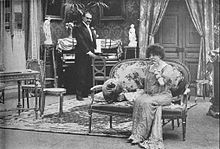Film d'art
 A still from La Dame aux Camélias (1911) by Albert Capellani, with actress Sarah Bernhardt. | |
| Years active | Late 1900s–early 1910s |
|---|---|
| Location | France |
| Major figures | |
| Influences | French theatre |
| Influenced | Narrative cinema |
Film d'art (French for "art film") was an influential film movement or genre that developed in France prior to World War I and began with the release of L'Assassinat du duc de Guise (1908), directed by Charles Le Bargy and André Calmettes of the Comédie Française for the Société Film d'Art, a company formed to adapt prestigious theatre plays starring famous performers to the screen.[1] The success of L'Assassinat du duc de Guise inspired other companies to make similar films, initiating the film d'art movement.[1] Among them were Pathé, which started a film d'art division called Société Cinématographique des Auteurs et des Gens de Lettres (SCAGL).[2] Examples of films d'art include Calmettes's La Duchesse de Langeais (1910) and La Dame aux Camélias (1912), and Albert Capellani's Notre-Dame de Paris (1911) and Les Misérables (1913).[2]
The movement was the most serious attempt to relate cinema to forms of high culture such as literature and theater, since up to that time cinema was seen as a simple popular entertainment characterized by spectacle.[2] Despite its high intellectual aspirations, film d'art was characterized by its limited narrative execution, as the works were simply filmed theatrical productions.[1] Despite its technical limitations and short-lived popularity, the movement was highly influential and instrumental in the rise of feature films and narrative cinema, as opposed to the cinéma d'attractions (English: "cinema of attractions").[1] The movement created a demand for more developed storylines and greater production values, and also made the practice of listing credits more widespread, as they advertised the presence of well-known stage actors.[2] The influence of film d'art resulted in the birth of narrative cinema in other countries, as in the case of Argentina with the work of Mario Gallo.[3]
Text is available under the CC BY-SA 4.0 license; additional terms may apply.
Images, videos and audio are available under their respective licenses.
